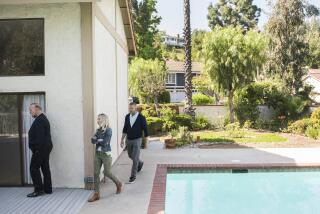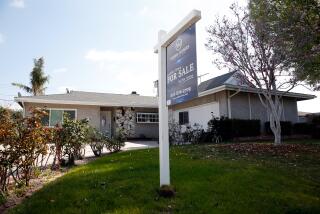A split-level market
AS the spring buying and selling season hits its stride, the local home market looks like two different places, depending on the price range.
It’s a buyer’s market in the broadest swath of homes, priced from about $550,000 to $10 million. But at the extremes, sellers still control the action. “A bit of a hybrid” is how Leslie Appleton-Young, chief economist for the California Assn. of Realtors, characterizes it. “What I’m hearing is a real mixed bag.”
Sales for March in the Los Angeles region were down 4.6% over the same period last year as the median home price ticked up 2.6% to $571,110, according to the association. Statewide, the picture was grimmer, with sales falling off a sharp 20.8%.
Yet for entry-level homes, it’s “still quite competitive,” said Raphael Bostic, interim associate director of USC’s Lusk Center for Real Estate. “Those homes are going to turn fairly quickly.” Take, for example, the 1,100-square-foot fixer-upper on a busy street in Granada Hills listed in late March for just under $500,000. The three-bedroom ranch-style house attracted six offers within two days, said agent Andrea Volore, with Coldwell Banker Woodland Hills. It is in escrow for close to the asking price.
A similar anecdote is recounted by Octavio Solorio, with Rodeo Realty Inc. in Studio City. Two days after he listed a two-bedroom, one-bathroom bungalow in Van Nuys, the owner received four offers. That deal closed at the end of March for close to the asking price of $550,000.
“There are a lot of buyers for the low end of the market,” Solorio observed.
Although Bostic characterizes the starter-home sector as a “place where we still have a seller’s market” due to demand, the buyers face steep financial hurdles.
Ryan Ratcliff, an economist with the UCLA Anderson Forecast, cites the implosion in the sub-prime mortgage business. That, he said, coupled with tougher lending standards, could sideline some potential buyers.
USC’s Bostic agrees. “You are going to see fewer no-documentation loans,” he said, “that don’t require income verification” and that are popular with buyers who have poor credit.
*
Deals that turn sour
Already, L.A.-area agents are starting to see the ramifications of tighter lending practices. Escrow companies don’t report the number of purchases that fall out, or the reasons, but agents who work with low-income buyers believe they are seeing more deals sour.
“Maybe 15% are falling out,” said Solorio, who works with many low- or no-down-payment clients.
“Buyers think they’re going to qualify. They have a ‘friend’ who’s going to get them the loan,” he said, but then the mortgage doesn’t materialize. Others have credit problems, he said, that scuttle the deal.
Solorio’s observations were echoed by agent Volore.
“We have quite a few things that are falling out of escrow,” she said. “People are having a lot of trouble keeping the deal together.”
At the stratospheric opposite end of the market, where homes are priced over $10 million, it’s also “more of a seller’s market,” said Betty Graham, president of Coldwell Banker’s Greater Los Angeles division, which has 3,800 agents and 45 offices.
On the Westside, 29 sales closed in the first quarter of the year for more than $10 million, compared to last year’s 25 for the same period, reported Beverly Hills broker Cecelia Kennelly-Waeschle, who tracks this sliver of the market. At $20 million and above there were seven sales, compared to two for the same quarter in 2006.
Among the sales was a 50,000-square-foot home on 25 acres in the Beverly Hills post office area; listed at $33 million, it went for $35 million.
But it is in the fat middle of the market where buyers are showing their fickleness. Coldwell Banker’s Volore has seen buyers back out during the contingency period if another house comes on the market that they like better.
And buyers aren’t rushing. Houses, in general, are taking longer to sell. In Los Angeles County, homes stayed on the market an average of 54.6 days in March 2007, up from 36.8 days a year earlier. In March 2004, it was just 20.9 days.
“Buyers think if they wait a little longer, they are going to be able to grab a better price, a lower price,” agent Solorio said.
Some are willing to wait much longer than others.
“I have buyers who have been looking for years,” said Natalie Neith, an agent with Prudential California Realty, John Aaroe Division, Hancock Park.
Buyers like John Moody. Neith sold Moody’s Victorian near downtown Los Angeles for $479,000 in 2004, a hefty gain from the $170,000 that he and his partner paid in 1996 at the nadir of L.A.’s last buyer’s market.
Moody then rented and waited for home prices to fall. They didn’t. Tired of waiting, he went on a buying spree out of state in 2006. He bought a three-bedroom, 2 1/2 -bathroom condo in his hometown, Greenville, S.C., for $65,000. He spent $31,000 for a two-bedroom, one-bathroom house in Danville, Ill. In nearby Indianapolis, he bought a restored Victorian with two bedrooms and one bathroom for $32,000. He rents out those properties and continues looking in L.A.
The way Moody figures it, “Now that there are so many properties around, prices are coming down.”
There is more to chose from. The California Assn. of Realtors’ Unsold Inventory Index in Los Angeles County -- a ratio of listings to sales -- rose to a 9.6-month supply as of last month from a 5.2-month supply in March 2006, Appleton-Young said. In March 2004, it was at 1.2.
“There are an ocean of listings compared to a year or two ago,” said agent Volore.
And when sellers vastly outnumber buyers, homeowners are more willing to offer concessions.
Agent Volore has seen it in action.
“Buyers are getting closing costs paid for, termite work paid for,” she said, and that “wasn’t happening” until recently.
*
Keep expectations in line
As the market continues to stabilize after a frenzied four-year boom that saw bidding wars and a surge in median prices, Appleton-Young said all parties must become more realistic in their expectations.
“A homeowner thinks, ‘My property will sell for 20% more than my neighbor’s did,’ and that’s not going to happen,” she said. “Home buyers expected to walk into Brentwood and Santa Monica to see prices drop 30%, and that hasn’t happened either.”
Time will tell.
Despite the overall uptick in the median price of a home in L.A. County, UCLA economist Ratcliff sees a less rosy picture ahead: “flat sales and falling prices.”
*
gayle.pollard-terry@latimes.com
More to Read
Inside the business of entertainment
The Wide Shot brings you news, analysis and insights on everything from streaming wars to production — and what it all means for the future.
You may occasionally receive promotional content from the Los Angeles Times.










